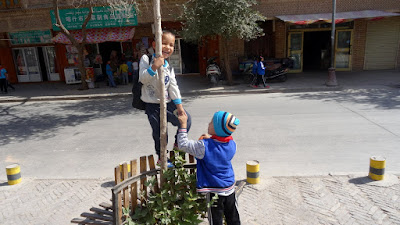Part 9 - Kashgar
Located in an oasis city in
the Taklamakan desert in Xinjiang Province in the very west of
China, close to the borders with Kyrgyzstan,
Tajikistan, Afghanistan, and Pakistan.
With a population of over 500,000, Kashgar
has a rich history of over 2,000 years and served as a trading post and
strategically important city on the Silk
Road between China, the Middle East, and Europe. Historically Kashgar (Kashi in Chinese) has been under the rule of the
Chinese, Turkic, Mongol, and Tibetan empires, experiencing a number of battles
between various peoples of the steppes. The population is 80% Muslim Uyghurs
and 20% Han Chinese.
The Restored Old City
In the recent years a great part of the old city has been restored and is called "the best-preserved example of a traditional Islamic city to be found anywhere in Central Asia"
(NY Times).
(NY Times).




Fresh, delicious bread






Islamic schools still exist, but only under very strict governmental observation

Kashgar, where the Silk Road starts


Ida Kah Mosque, 996-1442, the biggest mosque in China



The Dopa, the traditional Uyghur hat, is being worn by men and women



The Rawap instrument, usually with 6 strings. Left in the background Dutars, usually with 2 strings. The bowl of the Rawap is covered by snake skin.




This former palace is currently under restoration, the workers allowed us to explore the construction site.













Gao Tai, the Secretely Dying Old City
There is a second old city
which Kashgar doesn't want to be seen by tourists. Even the taxi driver first
refused to take us there. This part of the city is visibly decaying quickly.
Many houses have collapsed or at least are empty and locked. A few families
still live there.
It was not possible to
find out what its future will be. Will it be restored like the one shown above?
Unlikely, because it is in such a bad condition that it might be too costly,
so the picturesque houses will one day be replaced by newly built Chinese high
rises ...

A small private museum collects items from the old city - in a building which will not exist much longer







A family still lives here ...








Soon this fomer jewel of a traditional Islamic city will be gone ...
We say farewell to Kashgar, Tibet and China on a lovely pot of tea.


All photos by the author, apart from those
marked with 'www', which were taken from various internet sources.

Keine Kommentare:
Kommentar veröffentlichen